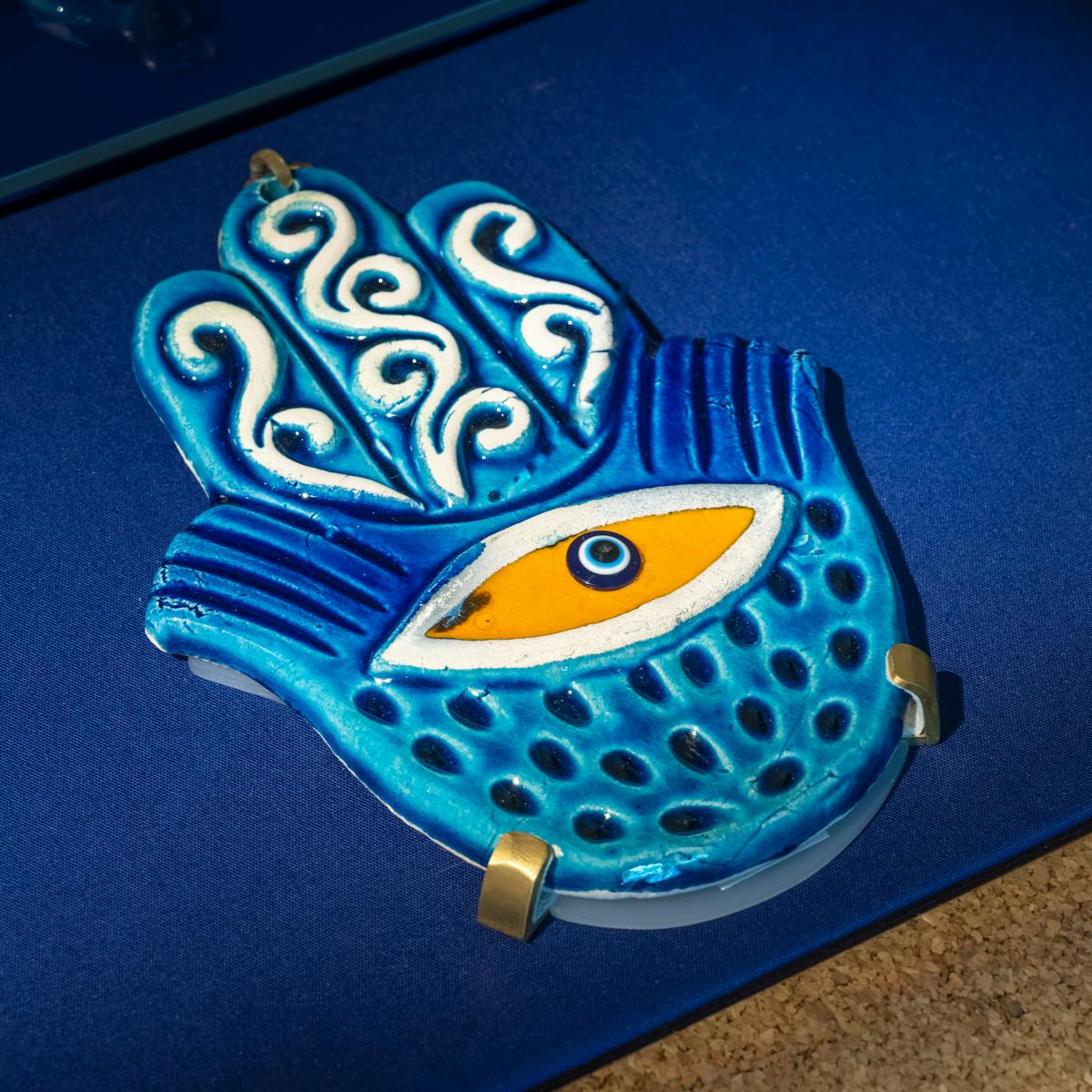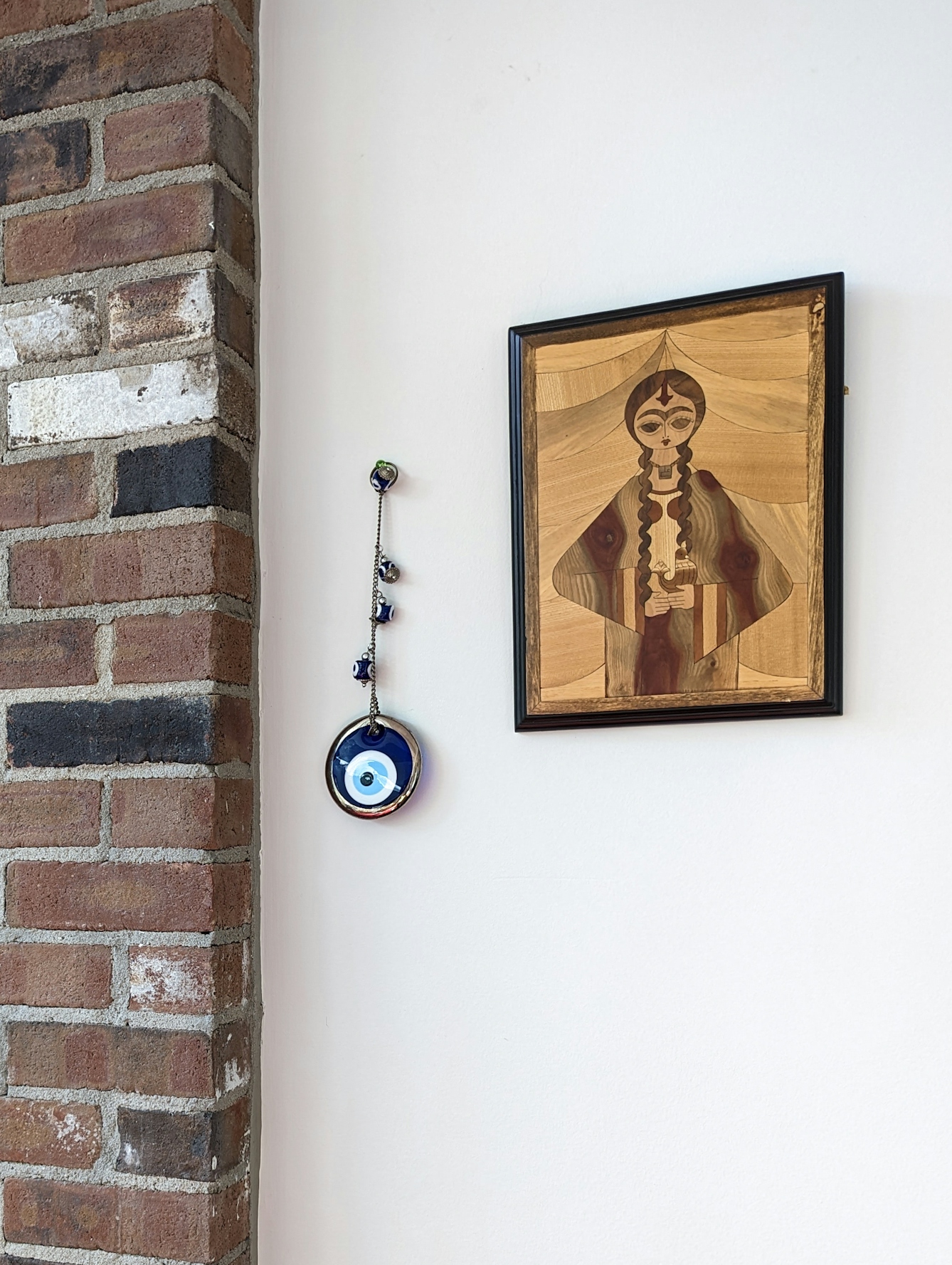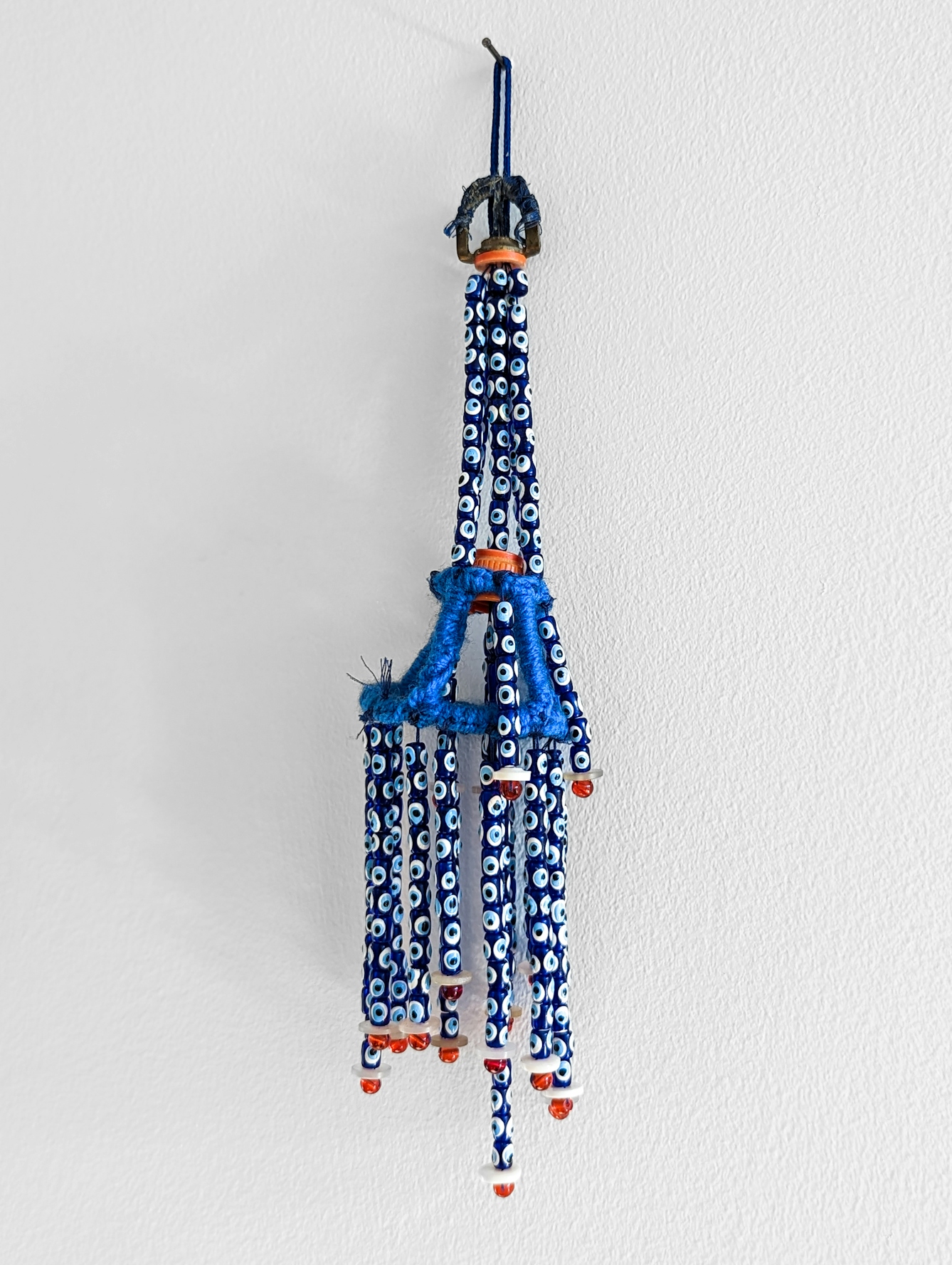Growing up in an Iranian family, Dr Shokoofeh Rajabzadeh has had her own dramatic encounters with the evil eye. The ‘look’ of the evil eye is believed to bring bad luck, illness or even death. The ancient curse might be deliberate, inflicted with an envious glare, or it could be accidental, the result of undue attention or excessive praise. Here Shokoofeh shares her experiences and suggests that a contemporary version of the ‘look’ lurks in the anxieties generated by social media.
The evil eye and social anxiety
Words by Shokoofeh Rajabzadehaverage reading time 9 minutes
- Article

On a visit to Iran in the summer of 2009, my aunts convinced my mother to call a clairvoyant to the house to break the curse that afflicted me. Over weeks of amber black tea and mint-and-feta sandwiches, my mum had told them the happenings of the past school year back in California.
How I had defied her and continued a relationship with another high schooler from our masjid, how he suffered a severe mental breakdown the night we tried to sneak out during the first big American football game at my school, and how his parents blamed me and threatened me aggressively over the phone.
On top of all this, I had contracted mononucleosis and lost ten pounds and still suffered from fatigue.
So I found myself sitting under the air-conditioning unit on a deep blue floral Persian rug, as the clairvoyant, Zari, turned my china cup over and looked at the coffee grounds, angling my palms towards the dimming sunlight at the window. She ‘reassured’ my mother and aunt that I had, in fact, been inflicted with the evil eye.
In mosques at Eid prayer and at every birthday party, we interacted as if evil eyes lingered in the air like dust, present even when not quite visible.
In minutes, I was standing with my feet shoulder-width apart, the soles of my feet against the cold kitchen tiles. Zari began to recite the Quranic Sura (chapter) ‘Al-Falaq’: “Say ‘O Prophet I seek refuge in the Lord of the daybreak from the evil of whatever he has created’.” My two aunts and mother pulled plastic wrap taut around a raw egg and handed it over to Zari as she continued to murmur in Arabic, “And from the evil of the night when it grows dark. And from the evil of those witches casting spells by blowing onto knots.”
She took the egg and slammed it between my legs as she punched the final line into the air, “And from the evil of an envier when they envy.”
Following Zari’s advice, my mother took me to the gold bazaar the next day and bought a small gold pendant engraved with ‘Ayatul Qursi’, the Quranic verse believed to protect its reciter from tragedy, misfortune, and the sting of the evil eye.
Back in California, I wore it against my bare skin until I regained my strength and was able to return to school. The boy’s parents seemed to no longer care about me, and I no longer cared for him. In other words, I wore it until the evil eye was deterred.
Family stories of the evil eye
The ‘evil eye’ is the superstitious belief that one can cause unintended or deliberate harm simply by noticing or complimenting someone or something. It has a lengthy history. Warnings against the evil eye circulate in scripture, literature, poetry and historiographies, from classical antiquity to the current day around the world. Although the superstition is not explicitly mentioned in the Quran, there are many other references to it in the Islamic tradition.
Muslims often cite verse five of sura ‘Al-Falaq’ in the Quran to suggest that envy has destructive power: “And from the evil of an envier who envies.” The Quranic verse that comes closest to referencing the evil eye is verse 51 of sura ‘Al-Qalam’, though even that is vague and indirect: “And verily those who disbelieve would almost make you slip with their eyes.”
Most famously, there is an Arab-Bedouin saying that some ascribe to the Prophet Mohammed: “The evil eye can bring a man to his grave, and a camel to the cooking pot.”

This 19th-century Persian amulet inscribed with Arabic text is intended to ward off the ‘evil eye’. The evil eye is the widespread belief that some people can cause harm to others simply by looking at or drawing attention to them in a certain way.
In the world I grew up in, the threat of the evil eye always loomed over us. In mosques at Eid prayer and at every birthday party, we interacted as if evil eyes lingered in the air like dust, present even when not quite visible. Unlike most curses, the evil eye is not necessarily inflicted on those one dislikes. It is triggered by compliments, loving attention and praise, such as “What beautiful eyes your daughter has” or “Your new home has such warm light.” All of these compliments, if unaccompanied with a protective phrase, make one noticeable enough to become a target for the evil eye.
There is no one in my family in Iran or in my Muslim community in Bay Area, California who does not have an evil-eye story. My aunt recalls how her bridal tiara that held every guest’s attention during her wedding in 1979 cracked just as soon as the guests left. She suspects the unceasing stream of compliments eventually brought forth the sting of an envious evil eye.
My grandmother Aziz claims that the reason her youngest grandchild of just one year is still under average weight percentile is because the child’s mother unintentionally inflicted him with the evil eye.

This is one of three charms in the author’s house, hung as protection from the ‘look’ of the evil eye. A ‘look’ from the evil eye may be a deliberate attempt to cause harm, perhaps out of envy, or may be unintentionally caused, from pride or undue attention to good fortune.
Just as all of us have an evil-eye story, we all also know of someone who has been suspected of “possessing an evil eye”. Often, misfortune follows this person, and in extreme cases, people avoid social interactions with them. My father tells me that his great aunt was known among family and friends in Isfahan, Iran as having the evil eye.
“She knew it herself and avoided weddings, lest she inflict illness onto the newlyweds,” he recalls. His mother told him that when his great-aunt did decide to attend her favourite niece’s wedding, she first drank a long cup of tea and stared at a boulder in her backyard long enough that it split down the middle. Only then was she sure there was no more sting left in her eye.
My grandmother Aziz often tells me that whenever her neighbour would come over and compliment something in her home, that very object would break. “One day,” she tells me, interrupted by the bubbles of a hookah she’s smoking, “as she was leaving the house, she looked at the lamp and said, ‘Your lamp is so bright!’ and it popped and shattered into a thousand pieces right at our footsteps.”

A wall-hanging in Shokoofeh’s house made by her grandmother from iconic blue ‘evil eye’ beads, recycled bottle tops and wool.
Protection against the evil eye
When someone is suspected of possessing a sour eye, anecdotes connecting them to the evil eye bloom like rings of mushrooms wherever they go. The difference between coincidence and accusation is just a few anecdotes, the difference between being a suspect and being communally branded.
Whether you are religious or not, if you’ve grown up with the evil eye, as I have, you’re likely to find that there is something unshakeable about it. You can never completely dismiss it. Although I no longer ascribe to the superstition, I often find myself involuntarily unnerved by the possibility of being afflicted by or of inflicting another with the evil eye.
I will, along with my friends, echo the firm and commanding tone and tenor of the elders at the mosque, and insist that every compliment is quickly followed with “Mashallah” – “God has willed it”. This publicly ensures that if Zainab’s new Tesla ends up with a minor scratch the next day or Maryam’s plump six-month old contracts a cold after seeing me, it is not because of compliments we made to one another. “Mashallah” protects the subject of our admiration, as it also protects us from being suspected of possessing the evil eye.
The issues at the heart of the evil-eye superstition are, in fact, social anxieties universally acknowledged and shared: jealousy, envy, self-promotion, and navigating wealth inequality and privilege.
Even as we scoff when our mothers or grandmothers warn us against posting beautiful photos of our children to Instagram, or dressing up too much for a party, we all own at least one protective charm, pendant or amulet: a hamsa or hand of Fatima, an iconic deep-blue eye charm, or rue seeds and the accompanying rue-seed burner. In my home, I have hung not one but three different evil-eye charms, two of which my grandmother made out of recycled materials.
Though we rarely discuss the superstition explicitly among ourselves, it remains in social interactions like a fussy, unwanted guest. And it is difficult not to feel implicated when a friend takes precautions around me. Recently, I learned that our closest family friends deliberately do not hang photos of themselves on the walls of their home, lest their visitors bring or attract the evil eye when they visit.
They said they did it to be mindful, careful and conscious about showcasing what they have to those who may have not. Given how often we visited their home, I wondered whether they thought we could not appreciate their special family moments without envying them?

Shokoofeh’s third charm against the evil eye, also made by her grandmother, is a wall-hanging made from wool and rue seeds, also known as esfand. The seeds are traditionally burned and the smoke used to ward off the evil eye.
Social anxieties
The issues at the heart of the evil-eye superstition are, in fact, social anxieties universally acknowledged and shared: jealousy, envy, self-promotion, and navigating wealth inequality and privilege. Although direct social contact is different from social media interaction, psychologists and other researchers studying the emotional and even physical toll of social media content on users discovered that watching others display their good fortune and successful lives leads to more feelings of envy and less satisfaction with one’s own life. These studies imply that the way we share and display ourselves in the world is not without emotional and social consequence.
The core questions that this superstition encourages you to ask, regardless of how seriously you ascribe to it, are “Why do I want to share or show this right now to these people?” and “Why do I want to comment on another person?” In other words, it asks why you would want to draw attention to yourself or why would you choose to draw attention to someone else's life, even with the best of intentions.
I am increasingly convinced that mindful sharing in a world with growing wealth and health inequality is crucial. I am not convinced that the threat of the evil eye is the appropriate safeguard. I also know precisely in which corner of my stacked jewellery box that gold pendant of ‘Ayatul Qursi’ rests, should I need it again.
About the author
Shokoofeh Rajabzadeh
Dr Shokoofeh Rajabzadeh was born in Iran and raised in California. She received a PhD in English Literature from UC Berkeley. Her dissertation research, focused on the role race-making played in medieval storytelling and the role that storytelling played in medieval race-making.
